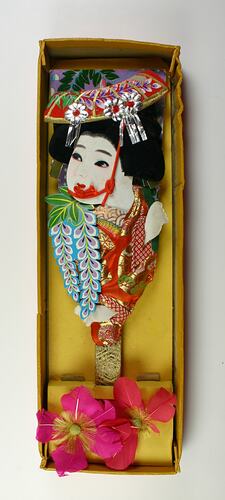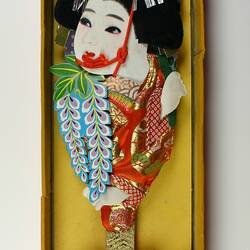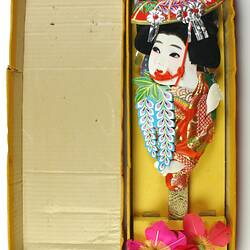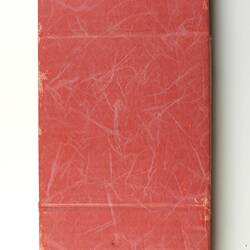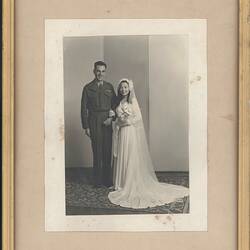Summary
Japanese hand puppet brought to Australia by Machiko Mizuta when she migrated as a war bride from Japan in 1952. Machiko Mizuta met Douglas Bryce, an Australian army engineer, during his posting to Kure in occupied Japan in the late 1940s, where she worked in an office. They married in Australia in 1953 and encountered both acceptance and prejudice before settling in a war service home in Clayton. Machiko remained in Australia with her children after Douglas' death.
Japanese brides initially received five year temporary residency visas. Then in 1956 after extensive lobbying by the Country Women's Association and the Returned Services League the law was amended to allow them to become citizens. This change was part of a gradually whittling away of the remnants of the White Australia policy.
Description of Content
Brown leather photo album with Egyptian design images etched in relief on front and back covers. Tan leather edging around cover. Inside front and back cover have stippled surfaces. Inside spine bound with brown leather strap threaded through two punch holes. 15 single sided stiff black card pages, each with four small sepia photographs attached with four brown paper photo corners. Each page has a title, date and each image a caption, all hand written in white ink. Every page is interleaved with off white (discoloured) tissue paper. The album commences at Tilbury dock, London, 25/2/1947 and progresses through Gibralta, north African coast, Port Said, Suez Canal, Aden, Ceylon (Colombo and Candy), Perth, and concludes in Melbourne at Warburton and Albert Park Lake, 27/3/1947. Images also include deck scenes and activities, and images of George Palmer, his wife Gertie and their daughters, Shirley and Lesley.
Physical Description
Japanese hand puppet consisting of wooden 'paddle' support with gold textile covering on handle. Reverse of paddle is painted with a red cherry blossom design. The front of paddle has floral fabric attached, predominantly in purple, green pink and blue. There is a head and torso figure of Japanese woman in tradition dress adhered 'in relief' onto front of paddle. The figure is made from stiff cardboard with painted face, woollen black elaborate Japanese hairstyle, red decorative headpiece with silver paper ribbon decorations, and orange fabric costume with paper hanging flower decoration from shoulder. The puppet is contained in a long flat cardboard box, pink exterior and yellow interior. Two flowers made from pink and red feathers attached to raised section of the inside of the box.
More Information
-
Collecting Areas
-
Acquisition Information
Donation from Mr Charles Bryce, Sep 2006
-
Place & Date Made
-
User
-
Classification
-
Category
-
Discipline
-
Type of item
-
References
From Kimono to Sushi. The Japanese in Victoria, Immigration Museum Community Gallery room brochure, 2006 [Link 1] (Australia-Japan Research Project)
-
Keywords
Japanese Communities, Japanese Immigration, Japanese Toys, Puppets, War Brides, Weddings
